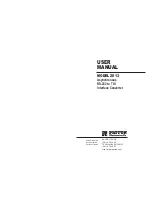
www.procontechnology.com.au
9 Phone: (03) 98306288
4. SAFETY
Generally speaking, Meanwell DC-DC converters are manufactured to produce an isolated stabilized DC supply. Converters
with high voltages (greater than 60VDC) must not be used until incorporated into a suitable enclosure as required by local laws
and regulations. Please consult the relevant authority.
Electric Shock
High voltages may be present inside the converter. Do NOT attempt to repair the unit or remove the cover. If the unit needs
service or repair return it to Mean Well or an authorized Mean Well repair centre. When the unit is installed in a system, be sure
that the case is properly grounded. Some units are 'Open Frame' and supplied without a case. Use extreme caution when
touching or removing these units for repair. Appropriate safety equipment and procedures must be used when touching or
removing the units where high voltages are present.
High Operating Temperatures
When the unit is operating at high output or is faulty, internal component temperatures may exceed 100ºC. Do NOT touch any
components inside the case. The external case temperature may also be at a point where it is unsafe to touch.
Keep all flammable, explosive, and volatile materials away from any DC-DC converter.
Rated Input Voltage
The input voltage of the DC-DC converter, by design, is limited. It can be dangerous to apply voltage which is outside of the
specified range, damage may occur to the unit. Always operate it within its specified input voltage range. Always check the
polarity of the input voltage before applying power.
Leakage Current
The internal noise filter capacitors generate a leakage current within the range specified by international safety standards.
However, if two or more units are used, the leakage current increases and electrical shock may occur. Take measures such as
securely grounding the unit, to prevent electric shock.
Wiring Materials
To prevent wiring materials from heating up or igniting, use the correct gauge of wire which can withstand the output current
capacity of the unit. Also, check the rated voltage of any wire used.
Shared Usage
It is particularly important to be careful when the current is diverted for use by a low current load. If a thin wire is used as a
branch line, the overcurrent/overload protection circuit may not work if the load is short-circuit. To ensure safety, attach a
suitably rated fuse, circuit-breaker or other protection device (resettable fuse or polyswitch) to the low-current wire as shown in
Fig. 19. Remember, overloading of circuits beyond their capacity causes overheating of cables and conductors, and can result in
direct fire hazards or, more often, in damage to insulation with the development of arcing or sparking.
Fig. 19































